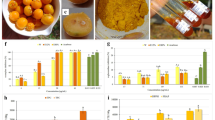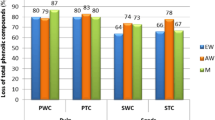Abstract
Dwarf elder (Sambucus ebulus L.) berries are rich in health-promoting phytochemicals such as polyphenols and anthocyanins, and display a significant antioxidant activity. They are also rich in two lectins (ebulin f and SELfd) that share amino acid sequence homology with the elderberry allergen Sam n1 present in Sambucus nigra pollen and fruits. Ebulin f displays toxicity by oral ingestion. This study was aimed at eliminating the toxicity of these lectins whilst having little or no effect on the antioxidant properties of dwarf elder berries. We thus investigated the potential effects of incubation in a boiling water bath of extracts from several parts of the plant on total polyphenol content, antioxidant activity, total anthocyanins, cyanidin-3-glycoside content, and the sensitivity of purified dwarf elder fruit lectins to a simulated gastric fluid. The study shows that five minutes of said heat treatment fully sensitized both lectins to pepsin digestion, whilst minimally reducing phenol and antioxidant as well as free radical scavenging activities to below 13 %. It proved possible to eliminate the potential risks derived from the presence of lectins in dwarf elder juices without any significant reduction in the content of the antioxidant compounds. Dwarf elder berries may thus be a valuable nutritional source.


Similar content being viewed by others
References
Szajdek A, Borowska EJ (2008) Bioactive compounds and health-promoting properties of berry fruits: a review. Plant Foods Hum Nutr 63(4):147–156. doi:10.1007/s11130–008–0097–5
Scalbert A, Manach C, Morand C, Rémésy C, Jiménez L (2005) Dietary polyphenols and the prevention of diseases. Crit Rev Food Sci Nutr 45:287–306. doi:10.1080/1040869059096
Tsuda T (2012) Dietary anthocyanin-rich plants: biochemical basis and recent progress in health benefits studies. Mol Nutr Food Res 56(1):159–170. doi:10.1002/mnfr.201100526
Wallace TC (2011) Anthocyanins in cardiovascular disease. Adv Nutr 2(1):1–7. doi:10.3945/an.110.000042
Ding M, Feng R, Wang SY et al (2006) Cyanidin-3-Glucoside, a natural product derived from blackberry, exhibits chemopreventive and chemotherapeutic activity. J Biol Chem 281(25):17359–17368. doi:10.1074/jbc.M600861200
Mariotti Lippi L, Bellini C, Mori Secci M (2010) Palaeovegetational reconstruction based on pollen and seeds/fruits from a bronze age archaeological site in Tuscany (Italy). Plant Biosyst 144(4):902–908. doi:10.1080/11263504.2010.491978
Kaack K, Austed T (1998) Interaction of vitamin C and flavonoids in elderberry (Sambucus nigra L.) during juice processing. Plant Foods Hum Nutr 52:187–198. doi:10.1023/A:1008069422202
Veberic R, Jakopic J, Stampar F, Schmitzer V (2009) European elderberry (Sambucus nigra L.) rich in sugars, organic acids, anthocyanins and selected polyphenols. Food Chem 114:511–515. doi:10.1016/j.foodchem.2008.09.080
Girbés T, Ferreras JM, Arias FJ, Stirpe F (2004) Description, distribution, activity and phylogenetic relationship of ribosome-inactivating proteins in plants, fungi and bacteria. Mini Rev Med Chem 4:461–476. doi:10.2174/1389557043403891
Liener IE (1994) Implications of antinutritional components in soybean foods. Crit Rev Food Sci Nutr 34(1):31–67. doi:10.1080/10408399409527649
Stirpe F, Battelli MG (2006) Ribosome-inactivating proteins: progress and problems. Cell Mol Life Sci 63(16):1850–1866
Jimenez P, Tejero J, Cabrero P, Cordoba-Diaz D, Girbes T (2013) Differential sensitivity of D-galactose-binding lectins from fruits of dwarf elder (Sambucus ebulus L.) to a simulated gastric fluid. Food Chem 136:794–802. doi:10.1016/j.foodchem.2012.09.011
Ferreras JM, Citores L, Iglesias R, Jimenez P, Souza AM, Gayoso MJ, Girbes T (2011) Occurrence of the type two ribosome-inactivating protein nigrin b in elderberry (Sambucus nigra L.) bark. Food Res Int 44:2798–2805. doi:10.1016/j.foodres.2011.06.004
Bromley J, Hughes BGM, Leong DCS, Buckley NA (2005) Life-threatening interaction between complementary medicines: cyanide toxicity following ingestion of amygdalin and vitamin C. Ann Pharmacother 39:1566–1569. doi:10.1345/aph.1E634
Buhrmester RA, Ebingerla JE, Seigler DS (2000) Sambunigrin and cyanogenic variability in populations of Sambucus canadensis L. (Caprifoliaceae). Biochem Syst Ecol 28(7):689–695. doi:10.1016/S0305–1978(99)00105–2
Jiménez P, Gayoso MJ, Tejero J et al (2013) Toxicity in mice of lectin ebulin f present in dwarf elderberry (Sambucus ebulus L.). Toxicon 61:26–29. doi:10.1016/j.toxicon.2012.10.009
Schwaiger S, Zeller I, Pölzelbauer P et al (2011) Identification and pharmacological characterization of the anti-inflammatory principal of the leaves of dwarf elder (Sambucus ebulus L.). J Ethnopharmacol 133(2):704–709. doi:10.1016/j.jep.2010.10.049
Süntar IP, Akkol EK, Yalçin FN, Koca U, Keleş H, Yesilada E (2010) Wound healing potential of Sambucus ebulus L. leaves and isolation of an active component, quercetin 3-o-Glucoside. J Ethnopharmacol 129(1):106–114. doi:10.1016/j.jep.2010.01.051
Kiselova Y, Ivanova D, Chervenkov T, Gerova D, Galunska B, Yankova T (2006) Correlation between the in vitro antioxidant activity and polyphenol content of aqueous extracts from bulgarian herbs. Phytother Res 20:961–965. doi:10.1002/ptr.1985
Förster-Waldl E, Marchetti M, Schöll I et al (2003) Type I allergy to elderberry (Sambucus nigra) is elicited by a 33.2 kDa allergen with significant homology to ribosomal inactivating proteins. Clin Exp Allergy 33(12):1703–1710. doi:10.1111/j.1365–2222.2003.01811.x
Prior RL, Wu XL, Schaich K (2005) Standardized methods for the determination of antioxidant capacity and phenolics in foods and dietary supplements. J Agric Food Chem 53:4290–4302. doi:10.1021/jf0502698
Apak R, Guclu K, Ozyurek M, Karademir SE (2004) Novel total antioxidant capacity index for dietary polyphenols and vitamins C and E, using their cupric ion reducing capability in the presence of neocuproine: CUPRAC method. J Agric Food Chem 52:7970–7981. doi:10.1021/jf048741x
Reis FS, Barros L, Martins A, Ferreira ICFR (2012) Chemical composition and nutritional value of the most widely appreciated cultivated mushrooms: an inter-species comparative study. Food Chem Toxicol 50:191–197. doi:10.1016/j.fct.2011.10.056
Giusti MM, Wrolstad RE (1996) Characterization of red radish anthocyanins. J Food Sci 61:322–326. doi:10.1111/j.1365–2621.1996.tb14186.x
Terry LA, Chope GA, Bordonaba JG (2007) Effect of water deficit irrigation and inoculation with Botrytis cinerea on strawberry (Fragaria x ananassa) fruit quality. J Agric Food Chem 55(26):10812–10819. doi:10.1021/jf072101n
Bermúdez-Soto MJ, Tomás-Barberán FA (2004) Evaluation of commercial red fruit juice concentrates as ingredients for antioxidant functional juices. Eur Food Res Technol 219(2):133–141. doi:10.1007/s00217–004–0940–3
Oliveira C, Amaro LF, Pinho O, Ferreira IM (2010) Cooked blueberries: anthocyanin and anthocyanidin degradation and their radical-scavenging activity. J Agric Food Chem 58(16):9006–9012. doi:10.1021/jf101923w
Yue X, Xu Z (2008) Changes of anthocyanins, anthocyanidins, and antioxidant activity in bilberry extract during dry heating. J Food Sci 73(6):494–499. doi:10.1111/j.1750–3841.2008.00845.x
Carvalho MRB, Sgarbieri VC (1997) Heat treatment and inactivation of trypsin-chymotrypsin inhibitors and lectins from beans (Phaseolus vulgaris L.). J Food Biochem 21(4):219–233. doi:10.1111/j.1745–4514.1997.tb00216.x
Shandilya UK, Kapila R, Haq RM, Kapila S, Kansal V (2013) Effect of thermal processing of cow and buffalo milk on the allergenic response to caseins and whey proteins in mice. J Sci Food Agric 93(9):2287–2292. doi:10.1002/jsfa.6041
Acknowledgments
This work has been supported by grants from the Regional Government of Castilla y León (GR106 and the Regional Health Ministry) and UVa-GIR.
Conflict of Interest
The authors declare no conflict of interest.
This article does not contain any studies with human or animal subjects.
Author information
Authors and Affiliations
Corresponding author
Rights and permissions
About this article
Cite this article
Jimenez, P., Cabrero, P., Basterrechea, J.E. et al. Effects of Short-term Heating on Total Polyphenols, Anthocyanins, Antioxidant Activity and Lectins of Different Parts of Dwarf Elder (Sambucus ebulus L.). Plant Foods Hum Nutr 69, 168–174 (2014). https://doi.org/10.1007/s11130-014-0417-x
Published:
Issue Date:
DOI: https://doi.org/10.1007/s11130-014-0417-x




